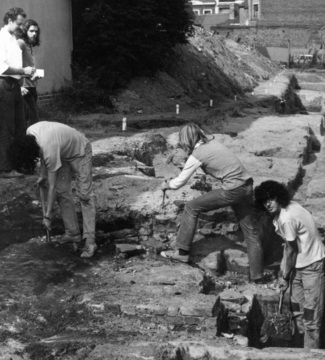 Gordon AB Young
Nottingham City Archaeologist, Gordon AB Young was involved
with the caves project at an early stage, and carried out recording of works at
the Castle especially in the 1980s and 1990s.
Gordon AB Young (pictured on the left at a dig) first worked
as an archaeologist in Nottingham in 1972, working for his brother Charles on
an excavation in the Lace Market. Having enjoyed working on excavations he
decided to go to university in Cardiff to study archaeology and returned to
Nottingham during summer breaks in order to gain experience, helping run sites
at Fisher Gate and Halifax Place.
After a period working in the northeast,
Gordon returned to Nottingham in 1983 when he was appointed Assistant Field
Archaeologist and was given the task of attempting to write up one of
Nottingham's most complex excavations.
In 1995 Gordon was appointed City Archaeologist. As City
Archaeologist, working as adviser to the planning department, he oversaw major
excavations on the sites of the National Ice Centre and the tramworks in the
city, as well as carrying out some excavations at Nottingham Castle and
providing archaeological advice during the early stages of the Castle
Transformation project.
Back to top
|
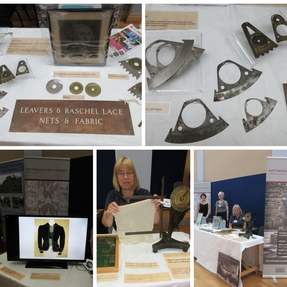 University of Nottingham Local History and Archaeology Day
Ann Inscker - Collections and Access Officer reports on this recent event...
"Having spent two years delighting attendees to the
Annual University Museum History and Archaeology Day event, to treasures from
Nottingham Castle’s caves, we decided to opt for something rather less
archaeological, though still at times equally dirty – our Designated Lace
collection.
We took along items from the Industrial Collection,
including precision engineered bobbins and carriages, lace tools, a jenny and
examples of Nottingham lace including a lace panel from the Robin Hood
Marathon, all to promote the Castle Transformation Project and current Arts
Council England (ACE) ‘Lace Unravelled’ Project.
Lace items from both the Costume and Industrial Collections
and Casson Mann draft images of the new Lace Gallery were shown on a large flat
screen TV, interspersed with an intriguing advert for lace makers Guy Birkin
Ltd, made in the 1980s and featuring our own Wollaton Hall.
Visitors and participants enjoyed the change to our usual
offering and came forward to regale us with their linked stories to the lace
industry, their love of engineering and to sign up to the lace newsletter.
Back to the broken pots next year, but for now lace has
definitely helped to draw both the Castle Transformation Project and our ‘Lace
Unravelled’ Project to the attentions of a heritage-hungry audience."
Back to top
|
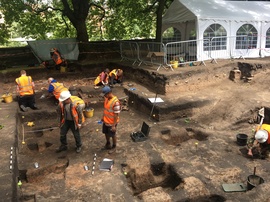 We Dig the Castle
Apprentice Jade Everatt visits the team on the latest excavation project at the Castle
"I was given a bright orange high-vis jacket and allowed to wander around the
dig which was very exciting! I found Bethany and Samantha
who were kind enough to let me interview them whilst they were hard at work. It
went a bit like this…"
What sparked your initial interest in archaeology?
Bethany: "My Nan was born in Egypt and she used to give me
lots of books about Egypt and they became my inspiration – I took GCSE History
and then A level Archaeology but that is no longer an option at A level I think
I was in the last year for it."
Samantha: "Well I was going to do classics at University but
then I realised there’s more money in Archaeology."
What have you been
doing here?
Samantha and Bethany: "We’ve just finished drawing this pit
which we are digging now to record it. This pit we’ve found
was just to drop rubbish down. As it’s a rubbish pit we’ve found lots of random
stuff (there was lots of pottery already visible) We’ve also had to
photograph it for evidence – sometimes they use an old style black and white
photo because they just need it as a record of evidence."
What are you enjoying
about it?
Samantha: "I enjoy the drawing, I’m no artist so I’m glad
it’s not too intricate."
Bethany: "Yes, me too. There are a lot of dotted lines."
Jade - "I found myself surprised by how much goes in to archaeology
from digging to drawing and taking photographs. The women explained that maths is
also involved when they have to measure things and that it's ‘a lot of
everything'."
What is your favourite
thing that you have found so far?
Samantha and Bethany: "Probably the crab shells which we
found in that bucket you can see there, you just find things people have thrown
away over the years it's so random."
Have you had chance to wander around the Castle? What is your favourite thing about the Castle and its history?
Samantha: "Probably the cave tour, it was really interesting
and the guy was all dressed up."
Bethany: "Yes, it was really interesting to learn what the
caves were used for."
Follow @wedigthecastle on Twitter or for more information, to see the calendar of activities, at the Trent and Peak website
Back to top
|
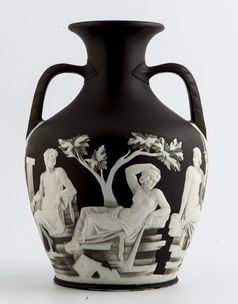 Object of the month
What is it?
The object
we have chosen to highlight this month is a technical masterpiece in
Jasperware. It is a rare first edition black and white Portland Vase, made by
the potter Josiah Wedgwood in about 1790.
Why is it significant?
Jasperware,
which was then a new material invented by Wedgwood, is considered to be the
most significant innovation in ceramic history since porcelain in China nearly
1,000 years earlier.
The Portland
Vase is one of the most famous Wedgwood products of the late eighteenth
century. Ours is number 29 from a
limited first edition of only 30 to 40 copies.
Wedgwood’s Portland
Vases are exact copies of an antique Roman cameo cut-glass vase made in c. AD 1
– AD 25 in Rome. This original vase is now
owned by the British Museum in London.
Tell me more
The Roman glass
vase became known as the Portland Vase, taking its name from the Duchess of
Portland, a noted collector of antiquities and one-time owner of the original
vase. After her death it was purchased in 1786 by her son, the 3rd Duke of
Portland, who lent it almost immediately to Josiah Wedgwood to copy.
This task was far greater than Wedgwood first anticipated. His first edition vases were the result of
four years of trials and tribulation, blistered and fractured failures and years
of work perfecting the Jasper body itself.
In our opinion
Our first
edition Portland Vase is amongst Josiah Wedgwood’s greatest achievements and amongst
his last. The quality of the reliefs on our copy is astonishing and beautiful. They are often undercut and tinted by hand
with a grey slip to give the effect of the translucency of the glass original. It
is a masterpiece. It was given
to the Museum in 1892 by the Wedgwood collector Felix Joseph.
Pamela Wood - Curator of Fine and Decorative Art
The Portland
vase will feature in the new Art as Inspiration Gallery currently being
designed by exhibition designers Casson Mann.
Further information
Read about the story of the
original Portland/Barberini Vase that Wedgwood borrowed to copy. This vase has had a colourful
history!
Back to top
|
Scott's findings
Welcome to column seventeen from City Archaeologist, Scott Lomax. This month, he explores the myth of another secret cave...
There has been a common belief that there are secret caves
in the city which extend long distances and connect to the Castle. One such
story, which has been told since the early 20th century if not earlier, is that
there is a passage leading from the Forest to the Castle. Another involves a
supposed cavernous tunnel leading from Bridlesmith Gate to the Castle.
Certainly there are a several cave passages which lead into
the Castle and land which once formed part of the Castle, including a cave
beneath Lenton Road. However, could there be any truth in stories of caves
stretching beneath much of the city centre?
The largest known cave system in Nottingham is quite close
to the Forest and runs for almost 200m in length beneath lots of properties on
Mansfield Road and surrounding streets. This cave system, which was an 18th and
19th century sand mine, is so large, and is quite a labyrinth, that people have
spent a number of hours walking in it. However, it does not go anywhere near
the Castle.
There is the old Great Central Railway tunnel which does run
from the Forest and beyond, and runs right into the Lace Market, but again this
does not extend to the Castle and was used for trains until the 1960s so could
not be the source of tales of people walking many miles when they were children
in the early 20th century or earlier.
In some cases these stories of a tunnel from the Forest were
told, in jest, to young relatives and were then believed and passed down the
generations with fiction becoming accepted as fact.
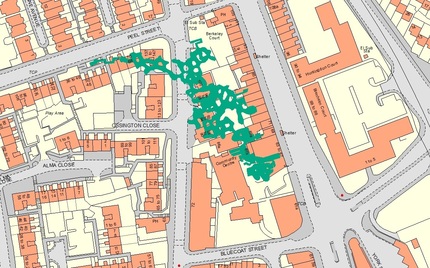 |
Peel Street Caves off Mansfield Road
What about a cave to the Castle from Bridlesmith Gate? Well,
the origins of this story date to the 19th century. A letter was printed in no
less than The Times in September 1862, written by Roger Brooke, Assistant
Surveyor to the Corporation of Nottingham, with the address given as 45 Low
Pavement, Nottingham. The letter was printed with the headline, 'Interesting
Discovery at Nottingham' and described discoveries made when 'alterations' were
made in the town, including demolition of old and derelict buildings. Following
the demolition of the pub named King John's Palace on Bridlesmith Gate a 'large
underground cell' was found and upon further investigation it was found to be
one of thirteen such cells. In one of the cells, the letter continued, pieces
of armour were found, along with weapons including a battleaxe. Furthermore three
skeletons were found. The evidence, according to Brooke, suggested the cave was
used as a prison and that the skeletons were prisoners. From these cave cells a
passage was said to extend all the way to the Castle.
The discovery of such caves, skeletons and artefacts would
have been far more than just interesting. It would have been remarkable, if
indeed there was any truth in it. The office of the Corporation Surveyors was
not on Low Pavement and there was no Roger Brooke working in the Surveyor's Office.
The Corporation Surveyor, Marriott Tarbotton, was able to confirm the letter
was a hoax and indeed there were many practical jokes at the time being
perpetrated by a man calling himself Rajah Brooke and Roger Brooke.
Nonetheless, once the claim had been put into print it was
believed by many, despite the Nottinghamshire Guardian highlighting the hoax.
Perhaps others who realised there was no truth in the story still liked to pass
it off as fact because it made an interesting tale.
It is these jokes and hoaxes that continued to be told into
the 20th century and which are still believed, by some, to be true.
Although there are no secret tunnels leading from the Forest
or Bridlesmith Gate the identification of 152 more caves beneath the city's
streets in the past twelve months is helping to change our understanding of
subterranean Nottingham and providing more details about the development and
social history of the city.
Back to top
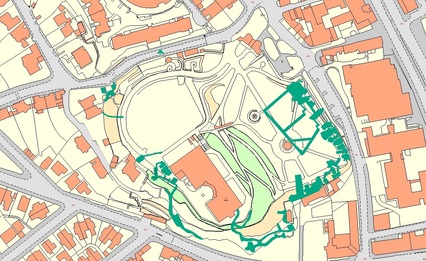 |
Caves at Nottingham Castle
|